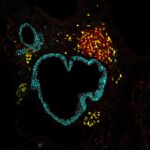
Publication: Innate lymphoid cells originate from fetal liver-derived tissue-resident progenitors.
Published in: Sci Immunol 2025 Jul; 10(109): eadu7962
Authors: Wang X, Li J, Rebuffet L, Cheng M, Bao B, Chen Y, Zheng X, Chen Y, Sun H, Sun R, Vivier E, Peng H, Tian Z
Summary
Committed progenitors with innate lymphoid cell (ILC) developmental potential are present in the fetus and bone marrow (BM). However, how fetal and BM hematopoiesis temporally and spatially contribute to ILC pools remains unclear. Here, we elucidated the distinct origins and developmental pathways of extramedullary and intramedullary ILCs in mice during ontogeny. ILC-restricted hematopoiesis is initiated in the fetal liver (FL), and then FL-derived PD-1+ ILC precursors (ILCPs) seed fetal lung and intestine. Organ niches determine the commitment of ILCPs to downstream precursors, including bipotent ILC1-ILC3 precursors (ILC1/3Ps), which preferentially reside in the liver and intestine, and ILC2 precursors (ILC2Ps), which are found predominantly in the lung. These precursors persist in adulthood and contribute to local ILC pools in a BM-independent manner. In contrast, intramedullary ILC2Ps and ILC2s rely on BM hematopoiesis. Thus, our study demonstrates that extramedullary and intramedullary ILCs have different origins and provides a comprehensive framework for ILC developmental dynamics.
Link to Pubmed [PMID] – 40644510
Link to DOI – 10.1126/sciimmunol.adu7962

